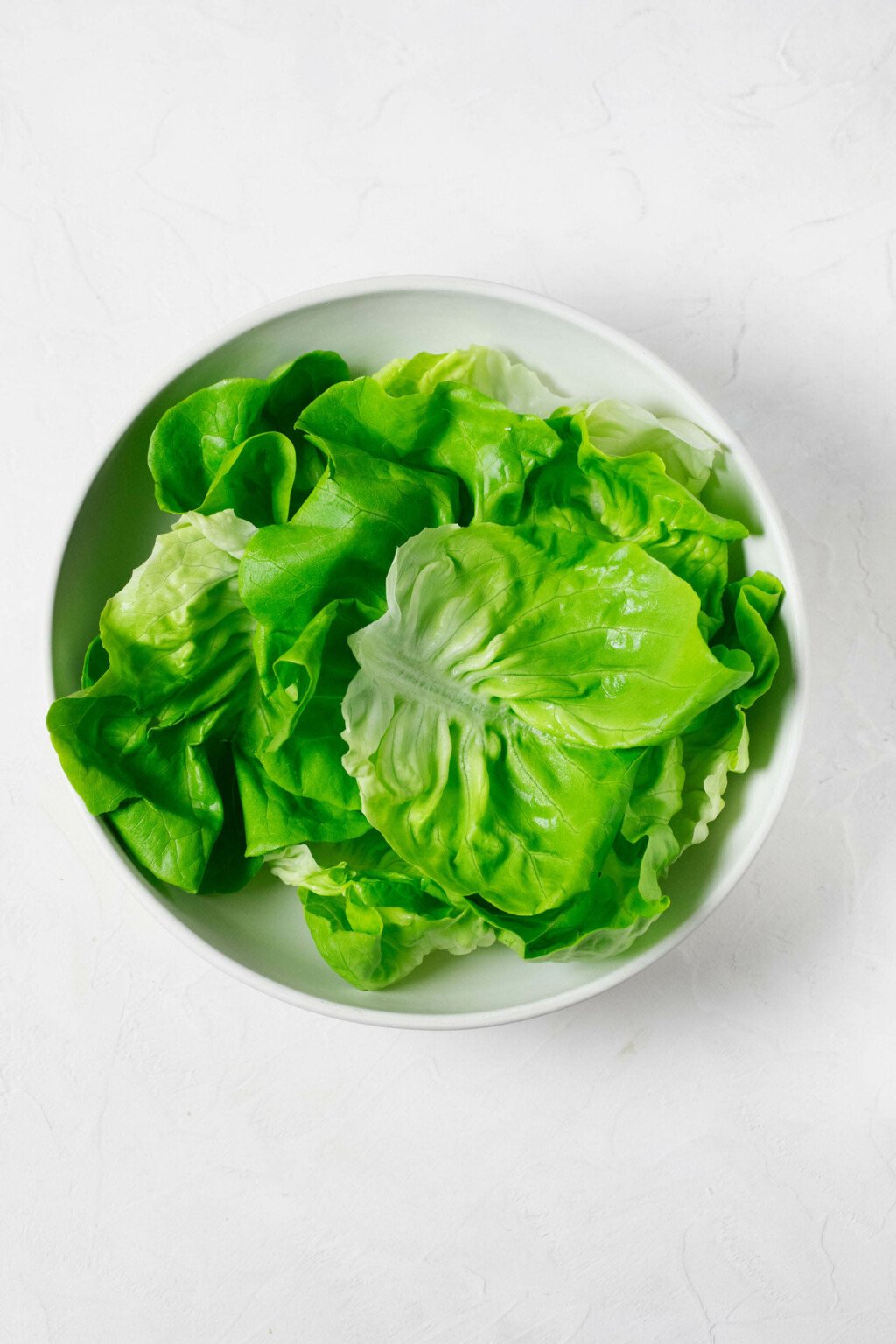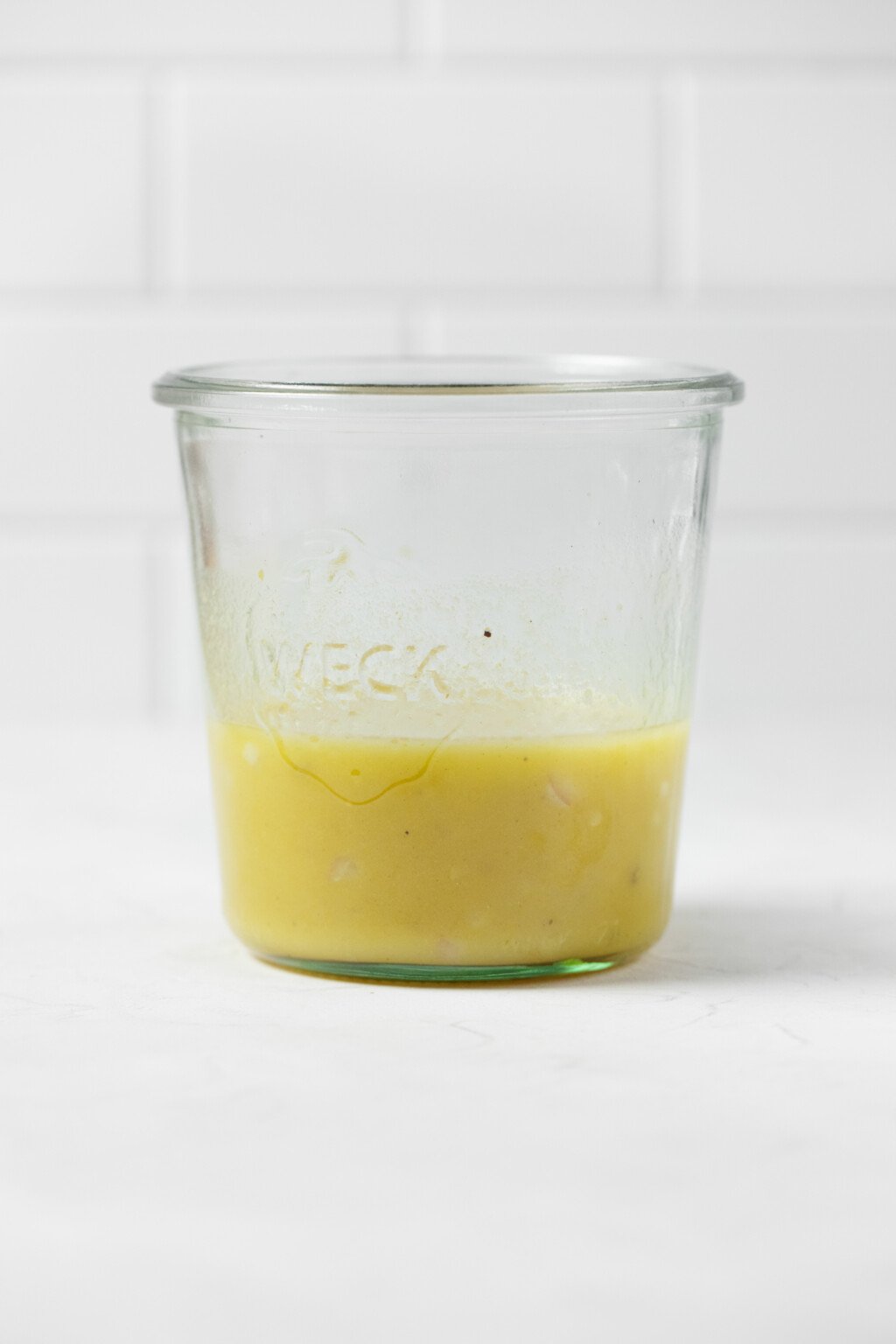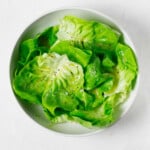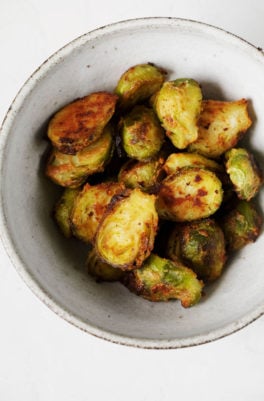This is my favorite quick and easy butter lettuce side salad. It’s the perfect fresh, green accompaniment to any lunch or dinner. The salad features round, tender butter lettuce leaves and a simple Champagne vinaigrette. It’s versatile, crowd-pleasing, and nutritious!

On Friday, when I shared my go-to Champagne vinaigrette, I promised that I’d also share my favorite green salad to put it on.
This is it: a quick and easy butter lettuce side salad that will add freshness, crunch, and flavor to any meal.
What do you mean by a side salad?
When I use the expression “side salad,” I’m really trying to distinguish this salad recipe from one of my meal-sized salads.
Generally speaking, my meal-sized salads function as Power Plates. They feature a protein source, a source of complex carbohydrates, and a source of healthy fat.
They cover their macronutrient bases, in other words.
My side salads usually feature greens and some source of healthful fat in the form of salad dressing. But they’re simple and light. These salads aren’t meals unto themselves, and they’re not trying to be.
Is the distinction between “side dish” and “main dish” a bit arbitrary? Sure it is.
A salad that’s predominantly vegetables or greens might be satisfying enough to serve as a meal, depending on the day and the preferences of the person eating.
Likewise, a sturdy grain salad or bean salad can be a side dish. It’s all circumstantial.
For the most part, though, I think of side salads as being predominantly greens or other vegetables, while a main dish salad has grains and beans (or other proteins) as well as greens.
Balance your plate
The beauty of a side salad, however you define it, is that it’s a way of completing a meal.
You may be familiar with MyPlate. MyPlate is a tool created by the USDA. It’s designed to help Americans plan and create balanced plates of food.
Like all tools that are created for widespread public use, MyPlate has limitations. It can’t possibly account for individual needs, lifestyles, or preferences.
I like to think of MyPlate as a suggestive planning principle, rather than a template to be followed exactly.
MyPlate recommends that about half of one’s plate should be vegetables, or a vegetables and fruit. The other two quarters are protein and starch, respectively.
MyPlate also suggests dairy to help people meet calcium needs; vegans can make a point of including calcium rich plant foods in their diets instead.
I don’t think that 50% needs to be a strict target, but I think the overall meal-planning principle is sound. I usually advise my nutrition clients to aim for making 30-50% of their plates be vegetables, within what’s realistic and sensible for them on any given day.
An exception to this would be the needs of eating disorder clients who have been malnourished and are in the process of nutritional repletion; for them, a Plate-by-Plate Approach®️ (50% starch) is more appropriate.
For vegans, covering about half of a dinner plate with vegetables is sometimes an easy task.
But even plant-based eaters may find that their entrées—for example, pasta dishes, which I eat many of—aren’t abundant enough in vegetables to singlehandedly create that vegetable-forward plate that MyPlate is suggesting.
This is where vegetable side dishes, including side salads, come in handy. They can function as tasty, nutrient-dense complements to your plant-based main dishes.
What is butter lettuce?
Of all of the many lettuce varieties out there, why is butter lettuce my go-to for side salads?
First, I should say what butter lettuce is. It’s a type of green lettuce that’s characterized by soft, large, round leaves.
The two types of butter lettuce that you’re most likely to encounter in American grocery stores are Bibb lettuce and Boston lettuce.
They’re quite similar, but Bibb leaves tend to come in tighter, smaller lettuce heads. The leaves themselves are sturdy and have some ridges.
Boston lettuce leaves tend to be a little flatter and softer. Heads of Boston lettuce may look looser and more “relaxed” than heads of Bibb lettuce.
In any case, texture is the thing that I love most about this type of lettuce. Butter lettuce has, just as its name implies, a very tender and buttery texture.

I also love the fact that butter lettuce has generously sized leaves.
I make plenty of kale salads, arugula salads, and salads with chopped romaine leaves. All of these salads feature bite-sized pieces of greens.
For the sake of variety and contrast, it’s fun to make side salads with big, floppy leaves—salads that require a fork and a knife!
Butter lettuce nutrition
I’m a fan of butter lettuce’s good nutrition just as much as I admire its texture.
The light green leaves of butter lettuce heads are good sources of folate and Vitamin A. They’re an excellent source of Vitamin K, which is important for proper blood clotting and for bone health.
In fact, a 100 gram serving of butter lettuce—that’s a generous serving, about three and a half ounces—has approximately 85% of the RDA, or recommended daily allowance, of Vitamin K for adults.
In addition, butter lettuce is more rich in iron than other types of lettuce. The same 100-gram serving contains about 15% of the RDA of iron for adult women.
Most of us know that dark, leafy greens are good sources of iron. By contrast, lettuces are not typically standout iron sources, but butter lettuce leaves deliver more iron than most.
Are baby butter and butter lettuce the same?
If you go shopping in the hopes of finding some butter lettuce, you may stumble on lettuce labeled as “baby butter” instead.
Baby butter has the same nutrition as Bibb or Boston lettuce, and its texture is very similar. The only difference is that baby butter leaves are smaller.
Whereas regular butter lettuce is very often sold as a whole head, with its core intact, baby butter leaves may be sold in a loose form.
The cores of baby butter heads may also be smaller and tighter than regular butter lettuce heads. I’ve seen them quartered and served wedge-style for salads, which is a great use for them.
If you’re looking to use butter lettuce for a lettuce cup or wrap, then the baby leaves will likely be too small. For salad recipes like this one, which feature loose leaves, baby butter lettuce leaves work well.
Can I use a different type of lettuce for this side salad recipe?
Much as I love butter lettuce, it’s not the only type of lettuce that will work well in this salad.
You could use any of the following types of lettuce in the recipe:
- Mesclun greens
- Oak leaf lettuce
- Tropicana lettuce
- Crisphead lettuce
- Red leaf lettuce
- Little gems
- Romaine hearts
- Frisée
- Baby romaine
- Mache
- Radicchio or escarole leaves
I prefer making this salad with a lighter type of lettuce or salad green, so I don’t typically use arugula, spinach, or kale.
However, baby spinach can be a stand-in for butter lettuce if that’s what you have at home.
A classic vinaigrette dressing
My absolute favorite dressing for this simple green salad with butter lettuce is my simple Champagne vinaigrette.
The thing I love about that vinaigrette is its balance. The dressing is tart, savory, and salty, with hints of Dijon mustard and a touch of sweetness, too. For me, it’s got an ideal proportion of tastes.
However, I think that a lemon vinaigrette—or just olive oil, lemon juice, salt and pepper to taste—would also be nice. If you love the flavor of red wine vinegar, you could try my Greek vinaigrette.
Regardless, I tend to think that vinaigrette dressings work better for lettuce salads than do creamy dressings, such as a tahini dressing.
That’s a big generalization, of course. But I think that creamy dressings tend to weigh delicate lettuce leaves down.
On the other hand, simple mixtures of olive oil and vinegar (or citrus) can coat butter lettuce leaves or other lettuce leaves in a way that preserves their delicacy and freshness.
How to make a simple butter lettuce side salad
One of my favorite things about this butter lettuce side salad is that it’s quick and easy to make.
I don’t mind spending a bunch of time on a meal-sized salad, but I like my side salads to be simple dishes that I can mix right as I’m about to serve dinner.
Fortunately, that’s about all you’ll need to do in order to make this recipe.
Step 1: Wash and dry your greens
If you’ve got an intact head of butter lettuce, simply detach the leaves before you wash and dry them. If you purchased whole leaves, then you can skip to the washing and drying.
I use my salad spinner to make this job faster.
Step 2: Whisk together your vinaigrette
You can prepare your vinaigrette ahead of time, of course. I like to make my Champagne vinaigrette weekly, so there’s usually a jar in my fridge.
If not, the vinaigrette should only take 5-10 minutes to make.

Step 3: Mix and season the salad
Next, you’ll transfer your greens to a mixing bowl and fold them together with the dressing.
Fold is really the operative word here. There are other, heartier and sturdier salads that respond well to vigorous tossing, but I think that big, delicate lettuce leaves do better with gentle folding.
Some salad recipes call for putting dressing at the bottom of the bowl, then adding greens and mixing. Others call for spooning the dressing on top of the salad leaves before mixing.
I don’t think that order of ingredients makes a big difference for this side salad. I usually place my lettuce leaves into a bowl, add dressing, then fold.
As for how much dressing to use, I recommend starting with 1/3 cup (80ml) for about five ounces of greens, or about eight handfuls.

It’s important not to overdress butter lettuce; you’re aiming for it to be glistening but not downright oily. Starting with a modest amount of dressing and continuing to add as needed is the best way to avoid an overdressed salad.
After you fold the butter lettuce with the right amount of dressing, you can add a few flakes of Maldon, or another flaky salt, and freshly ground black pepper.
There’s already salt and pepper in the dressing. This is just a finishing touch, to make sure that the salad is well-seasoned.

Step 4: Serve
Whereas some salads made with darker greens can be stored comfortably, I think that this butter lettuce side salad is best served right away.
If you need to get a head start on your food preparation, then you can make the dressing ahead of time. The Champagne vinaigrette will keep for up to one week in an airtight container in the fridge.
As for storing butter lettuce, I recommend leaving roots and cores intact if you’ve purchased a whole head.
Whether you have a head or loose leaves, try storing your butter lettuce with a damp (not wet) paper towel in an airtight container or silicone bag.
As a general rule, I’ve found that butter lettuce that’s stored this way will stay crisp and fresh for about five days. If you see any yellow, limp, or browning leaves, you can compost or discard them.
Optional elements
I’m a bit of a purist about this side salad; usually, it’s lettuce, dressing, salt, and pepper. No more, no less.
Once in a while, though, I like to add some snipped chives or finely chopped parsley leaves to the salad. This is a way to celebrate fresh herbs and add a little complexity to an otherwise very simple recipe.
You can add oregano, chopped basil leaves, chopped mint leaves, chives, parsley, or tarragon to the butter lettuce salad.
If you’re craving a little crunch, bread crumbs, croutons, vegan candied walnuts, crispy candied pecans, or toasted seeds make a nice addition as well.
What should I serve the butter lettuce salad with?
So many things!
I think that this salad is wonderfully versatile. I often serve it with sandwiches for lunch, reserving a few of the leaves to pile onto my vegan BLT or pickled vegetable and smoky tofu sandwich.
The butter lettuce side salad is great with any vegan pasta dish, soup, or casserole.
If you whip up an easy vegan protein, such as:
- Baked balsamic tofu
- Lemon pepper tempeh
- The best brothy white beans
- Baked smoky tofu
- Slow cooker tomato white beans
…as well as a whole grain dish, like:
- Savory mushroom farro
- Lemon dill zucchini chickpea rice
- Roasted butternut squash rice
- Cumin-spiced lentils and rice
- Citrusy sweet potato bulgur
…then adding this side salad will instantly give you a well-rounded, balanced dinner plate.
I’m sure you’ll think of countless more dishes to pair the side salad with. Here’s the recipe.

My Favorite Butter Lettuce Side Salad
Author –Ingredients
- 5 ounces butter lettuce leaves (150g, or about 8 handfuls)
- 1 batch simple Champagne vinaigrette
- Maldon salt (for finishing)
- Freshly ground pepper (for finishing)
- Optional: freshly snipped chives, oregano leaves, or finely chopped parsley, basil, or mint (for serving)
Instructions
- Place the greens in a roomy serving bowl. Add 1/3 cup / 80ml vinaigrette to start. Fold the salad gently, until all leaves are coated with dressing.
- Continue adding vinaigrette as needed, but be careful not to overwhelm the delicate lettuce leaves with dressing. They should be evenly, yet lightly coated.
- If you like, add fresh chopped chives or herbs.
- Taste the salad. Add a pinch of Maldon or other flaky sea salt and a little extra black pepper as needed, for finishing. Serve right away.
Many people crave hearty comfort food more in the winter months than in the summer, and for the most part, I do as well.
But I’ve noticed that I actually crave green salads more in the winter than at other times of year. This is in spite of the fact that summer wears the official label of salad season.
I think that these cravings are my body’s way of telling me that it needs color and freshness even when the days are short and produce is more limited.
A few local-to-me producers make greenhouse grown butter lettuce, so I’m very fortunate to be able to enjoy this crispy, pale green butter lettuce side salad all throughout the year.
I hope you’ll come to cherish it, too, and that you’ll soon serve it alongside something delicious.
xo
This post may contain affiliate links. If you use these links to buy something I may earn a commission. Visit my privacy policy to learn more.
Dietary Preferences: Gluten Free, Soy Free, Tree Nut Free, Vegan
Recipe Features: 30 Minute or Less





Leave a Comment